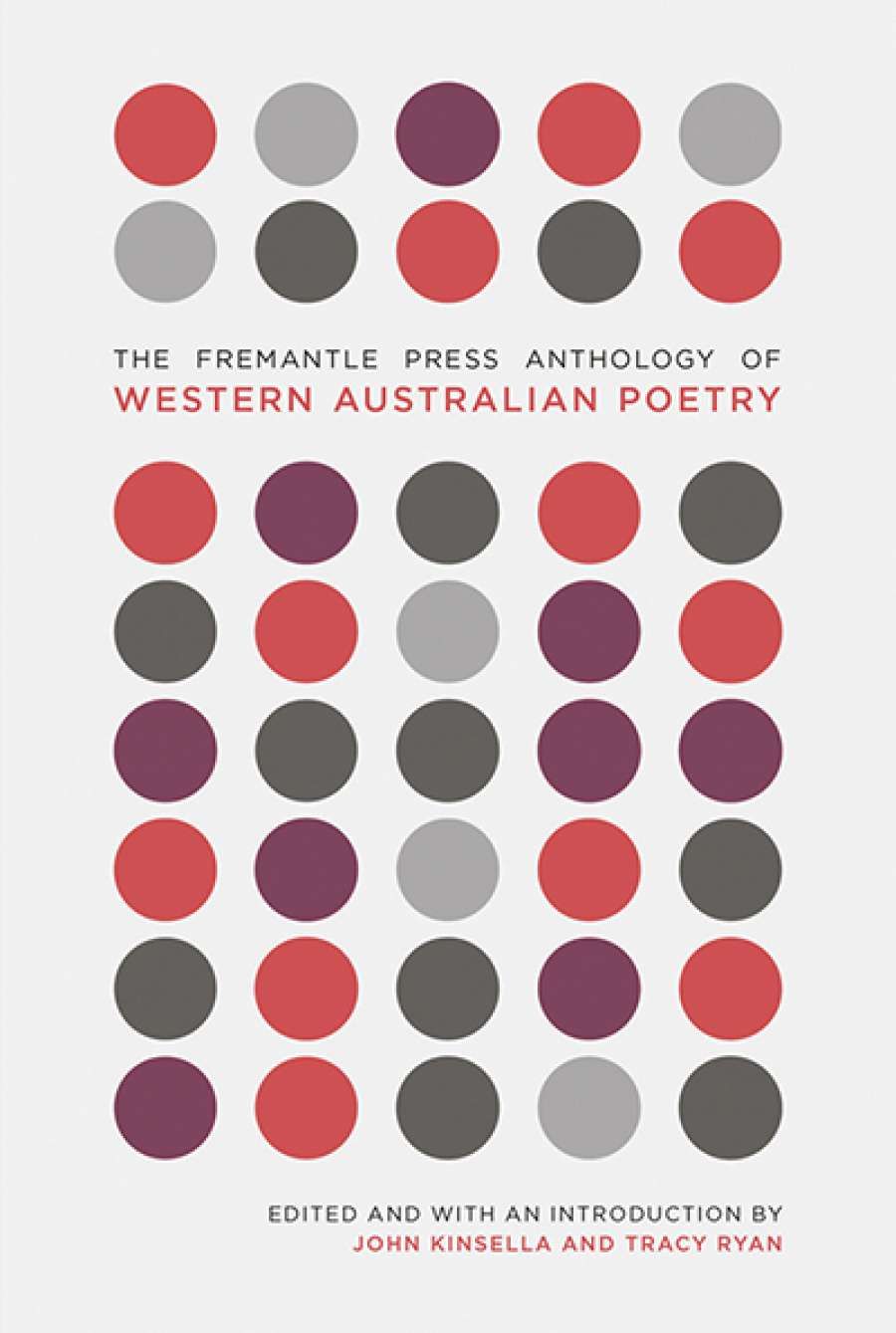
- Free Article: No
- Contents Category: Poetry
- Custom Article Title: Geoff Page reviews 'The Fremantle Press Anthology of Western Australian Poetry' by John Kinsella and Tracy Ryan (eds)
- Review Article: Yes
- Online Only: No
- Book 1 Title: The Fremantle Press Anthology of Western Australian Poetry
- Book 1 Biblio: Fremantle Press $34.99 pb, 376 pp, 9781925162202
The poems are arranged by their author’s birth dates (as far as they are known), so the reader begins, somewhat laboriously, in the mid-nineteenth century. There is little here to challenge the best of Lawson or Paterson, but by the 1890s there is a considerable momentum in the ‘Goldfields’ poetry of the pseudonymous ‘Crosscut’, ‘Dryblower’, and others. These poems give a vivid sense of the social and industrial life in 1890s Kalgoorlie, and have more than sufficient technique for their purposes.
By the 1920s the reader begins to encounter the relatively numerous Aboriginal poems in their original languages (with English translations) that Kinsella and Ryan have scattered judiciously throughout the text. They provide a nicely different aesthetic to the ‘European’ poems through which they are dispersed. They are interesting, too, for the relative enthusiasm with which their authors have often taken to European technology. A stanza (in translation) from Yintilypirna Kaalyamarra’s ‘The Coastline Looks Strange to Me from Out Here’ is a good example: ‘We’ll follow the wind, with the bow pointing east, / as the boat heels perfectly to match the change of course. / We cut the spray and turn it to tiny droplets, / the timber of the boat shakes / from the successive pounding of the waves.’ It makes an instructive contrast with, say, a stanza from ‘Acaster’s’ stereotypical ‘O’er a Native’s Grave’ published about forty years earlier: ‘No more with spears, and weapons rude, / Shal’t thou roam thro’ the woodland dell, / No more midst festive scenes shall sing / The wildsome songs you loved so well.’
The editors’ selection from the inter-war years also gives a sense of the richness to come in the 1950s and 1960s. There is a fine, very specific political poem, for instance, by the World War I veteran Oscar Walters, about the so-called ‘land fit for heroes’ as Western Australia went into the Depression of the 1930s. Well-known poets such as Kenneth ‘Seaforth’ Mackenzie (1913–55) and William Hart-Smith (1911–90) also feature, though the editors’ choices from the latter sell him a little short (none of them quite as good as ‘Baiamai’s Never-failing Stream’, for instance).
The real breakthrough, however, occurs with Dorothy Hewett (1923–2002). In poems such as ‘In Midland Where the Trains Go By’ and ‘Once I Rode with Clancy’, we encounter the fearless energy (even recklessness) that eventually made Hewett one of our most admired poets. ‘O once I rode with Clancy when my white flesh was tender, / And my hair a golden cloud along the wind, / Among the hills of Wickepin, the dry salt plains of Corrigin, / Where all my Quaker forebears strove and sinned.’
 Dorothy HewettAnother high point is obviously Randolph Stow (1935–2010), whose poems about the pastoralists’ unease with Aboriginal dispossession have rarely been equalled (perhaps only by Judith Wright). Along with Stow and Hewett, however, are gratifyingly good poems by poets who may well be unknown ‘over east’. These would include poems by William Grono (just the one), Griffith Watkins, Ee Tiang Hong, and Brian Dibble, among quite a few others.
Dorothy HewettAnother high point is obviously Randolph Stow (1935–2010), whose poems about the pastoralists’ unease with Aboriginal dispossession have rarely been equalled (perhaps only by Judith Wright). Along with Stow and Hewett, however, are gratifyingly good poems by poets who may well be unknown ‘over east’. These would include poems by William Grono (just the one), Griffith Watkins, Ee Tiang Hong, and Brian Dibble, among quite a few others.
In line with the editors’ decision to give proper space to Indigenous poetry, there is also a considerable quantity of more recent Aboriginal poetry in English. A few of these are close to how Oodgeroo Noonuccal once described her own poetry: ‘sloganistic, civil rightish, plain and simple’. Others, however, such as Jack Davis’s ‘John Pat’ and ‘The First Born’, Sally Morgan’s very simple ‘Janey Told Me’, and Charmaine Papertalk-Green’s ‘Blinding Loyalty’, are not easily forgotten. The same can be said for Robert Walker’s ‘Solitary Confinement’.
As is the case with most anthologies, the editors’ personal beliefs and predilections have an effect on their choices. Thus we can often have good, if slightly atypical, poems which show a poet’s greater-than-usual concern with eco-poetics. A reader familiar with the editors’ own work – and that of the poets being sampled – may find a knowing but not-dissatisfied smile cross his or her face.
One example of this is the choice of Andrew Taylor’s eight-page sequence, ‘Swamp Poems’ when he may have been better exemplified by four or five separate poems. The same is not true, however, of Fay Zwicky’s ‘Kaddish’ which also runs to eight pages but shows the poet at her most powerful and quintessential.
For anyone interested in the highways and byways of Australian poetry generally – and in the development of our poetic culture over the past couple of centuries (or sixty millennia) – Kinsella and Ryan’s anthology is mandatory reading.


Comments powered by CComment